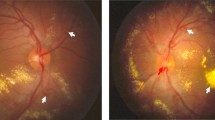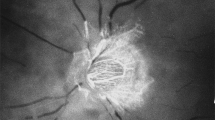Summary
In 4 different cases of rubeosis iridis specimens of iris tissue were fixed immediately after operation and investigated in light and electron microscopy. Numerous newly-formed vessels were observed in the anterior leaf of the iris. The stroma in the area of rubeosis shows copious mucoproteins and homogeneous masses. The iris surface is covered by numerous elongated cells which are highly activated, containing numerous cell organelles and inclusions. They overlap in layers.
The proliferated vessels in the region if the rubeosis are lined with endothelia which possess a remarkably great number of cell organelles. Abundant mitochondria, ribosomes, and vesicles are present in the cytoplasm. The endoplasmic reticulum is well developed. Many small cellular processes are evident. In some areas, the endothelial cells also showed fenestrations. Generally two forms of endothelial cells can be distinguished, i.e., a light and a dark type, whose characteristics are described.
The results of this study indicate an active proliferation of vessels. Besides capillary sprouts and loop formation, a new form of development of vessels probably occurs, namely, by “separation”. Abundant pecularities of endothelial structures in the area of rubeosis (endothelial bridges, formation of septa, etc.) are readily explained by a proliferation process of capillary “separation”.
The possible functional importance of the structural changes in rubeosis iridis is discussed.
Zusammenfassung
In 4 Fällen von Rubeosis iridis wurde operativ gewonnenes und lebensfrisch fixiertes Irismaterial licht- und elektronenmikroskopisch untersucht. Im Bereich des Irisvorderblattes finden sich zahlreiche neugebildete Gefäße. Das intervasculäre Stroma ist reich an Mucoproteiden und homogenen Massen. Die Oberfläche der Iris ist von zahlreichen, zum Teil stark aktivierten langgestreckten Zellen bedeckt, die sich schichtweise überlappen und verschiedenartige Einschlüsse enthalten.
Die proliferierten Gefäße im Rubeosisgebiet sind von Endothelien ausgekleidet, die einen auffallenden Reichtum an Zellorganellen und Zellfortsätzen besitzen. Besonders groß ist die Zahl der Mitochondrien, Ribosomen und Vesikel. Das endoplasmatische Reticulum ist stark entwickelt. Auch Fenestrationen wurden stellenweise beobachtet. Generell können zwei Endothelzellformen unterschieden werden, eine helle und eine dunkle Zellform. Die Befunde sprechen für eine aktive Gefäßproliferation, wobei neben Capillarsprossungen und Schlingenbildung wahrscheinlich noch eine neue Form der Gefäßneubildung, nämlich eine solche durch Spaltung vorkommt. Zahlreiche Besonderheiten der Endothelstrukturen im Rubeosisbereich (Endothelbrücken, Septenbildungen u.a.) finden durch die Annahme einer Gefäßproliferation durch capillare Aufspaltungsvorgänge eine zwanglose Erklärung.
Die mögliche funktionelle Bedeutung der rubeotischen Strukturveränderungen in der Iris wird diskutiert.
Similar content being viewed by others
Literatur
Ashton, N.: Neovascularization in ocular disease. Trans. ophthal. Soc. U. K. 81, 145–161 (1961).
—: Oxygen and the growth and development of retinal vessels, In vivo and in vitro studies. The XX Francis I. Proctor Lecture. Amer. J. Ophthal., Ser. III, 62, 412–435 (1966).
—, Pedler, C.: Studies on developing retinal vessels. IX. Reaction of endothelial cells to oxygen. Brit. J. Ophthal. 46, 257–276 (1962).
Brenk, H. A. S. van den: Studies in restorative growth processes in mammalian wound healing. Brit. J. Surg. 43, 525–550 (1955).
Chernukh, A. M., Alexeyev, O. V.: Vesiculatory processes in endothelium of blood capillaries under normal and pathological conditions. 5th Europ. Conf. Microcirculation, Gothenburg 1968. Bibl. anat., No 10, p. 256–260. Basel-New York: Karger 1969.
Cliff, W. J.: Observations on healing tissue: a combined light and electron microscopic investigation. Phil. Trans., Ser. B, 246, 305–325 (1963).
Cogan, D. G.: Vascularization of the cornea, its experimental induction by small lesions and a new theory of its pathogenesis. Arch. Ophthal. 41, 406–416 (1949).
Florey, H. W., Jennings, M. A.: Healing. In: General pathology. London: W. B. Saunders Company 1962.
François, J.: Rubeosis iridis. Ophthalmologica (Basel) 121, 313–333 (1951).
Heydenreich, A.: Das Verhalten der Hornhautvaskularisation im Tierversuch. Klin. Mbl. Augenheilk. 127, 465–471 (1955).
—, Schnabel, R.: Zur Klinik und Pathologie der Rubeosis iridis. Klin. Mbl. Augenheilk. 134, 350–363 (1959).
Illig, L.: Der Vorgang der Capillarsprossung. In: Pathologie und Klinik, Bd. X, Die terminale Strombahn. Capillarbrett und Mikrozirkulation. Berlin-Göttingen-Heidelberg: Springer 1961.
Majno, G.: Ultrastructure of the vascular membrane. In: Handbook of physiology, sect. 2, Circulation, vol. III, p. 2293, ed. F. W. Hamilton and P. Dow. Washington D. C.: Amer. Phys. Soc. 1965.
Matshashi, K.: Experimental study on the corneal vascularization. Report II, Electron-microscope observation on the corneal vascularization. Acta Soc. ophthal. jap. 66, 939–952 (1962).
Reynolds, S. E.: The use of lead citrate at high pH as an electron-opaque stain in electron microscopy. J. Cell Biol. 17, 208–212 (1963).
Richardson, K. C., Jarett, L., Finke, E. H.: Embedding in epoxy resins for ultrathin sectioning in electron microscopy. Stain Technol. 35, 313–323 (1960).
Salus, R.: Rubeosis iridis diabetica, eine bisher unbekannte diabetische Irisveränderung. Med. Klin. 24, 256–258 (1928).
Schoefl, G. I.: Studies on inflammation. III. Growing capillaries: their structure and permeability. Virchows Arch. path. Anat. 337, 97–141 (1963).
Smith, R. S.: The development of mast cells in the vascularized cornea. Arch. Ophthal. 66, 383–390 (1961).
Szegy, G.: Die Rolle der Schädigung im Mechanismus der experimentellen Hornhautvaskularisation. Albrecht v. Graefes Arch. Ophthal. 162, 215–218 (1960).
Tamura, T.: Electron microscopic study on the small blood vessels in Rubeosis iridis diabetica. Acta Soc. ophthal. jap. 72, 2340–2352 (1968).
Warren, B. A.: The ultrastructure of capillary sprouts induced by melanoma transplants in the golden hamster. J. roy. micr. Soc. 86, Pt. II, 177–187 (1966).
Wohlfarth-Bottermann, K. E.: Die Kontrastierung tierischer Zellen und Gewebe im Rahmen ihrer elektronenmikroskopischen Untersuchung an ultradünnen Schnitten. Naturwissenschaften 44, 287–288 (1957).
Author information
Authors and Affiliations
Rights and permissions
About this article
Cite this article
Okamura, R., Rohen, J.W. Elektronenmikroskopische Untersuchungen über die Rubeosis iridis. Albrecht von Graefes Arch. Klin. Ophthalmol. 182, 53–75 (1971). https://doi.org/10.1007/BF00406518
Received:
Issue Date:
DOI: https://doi.org/10.1007/BF00406518




